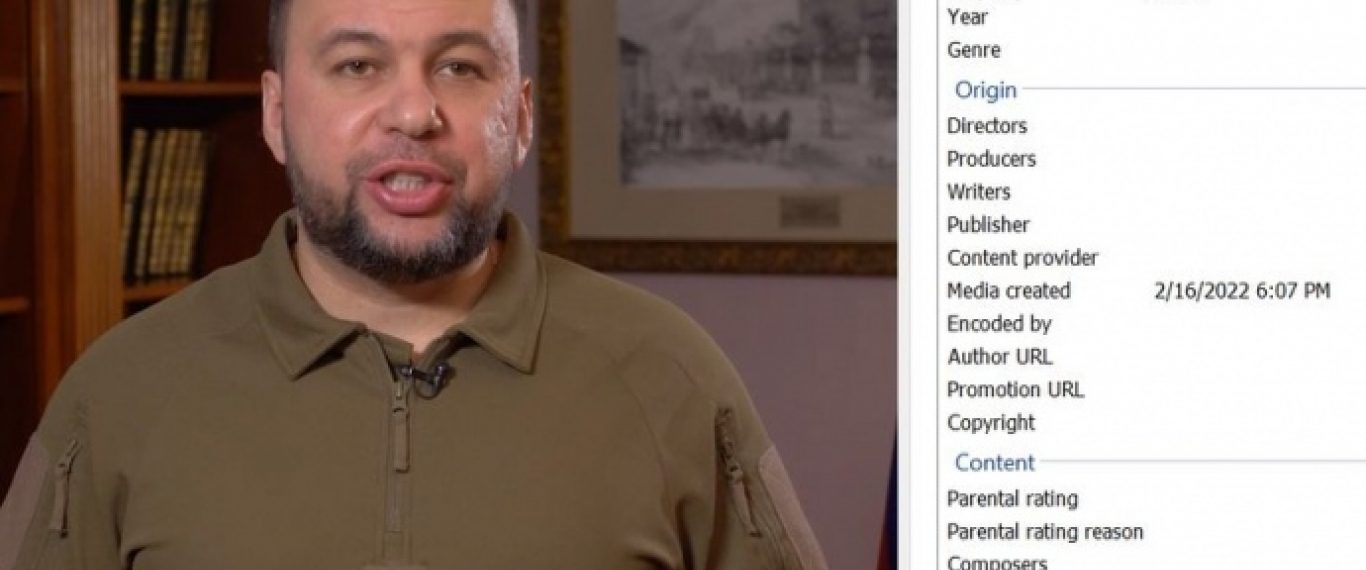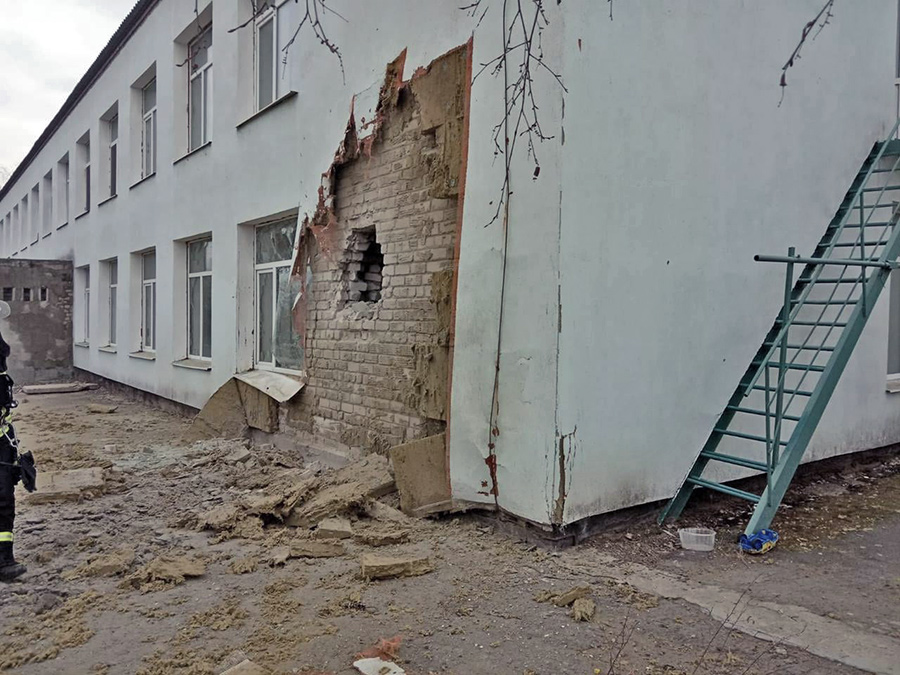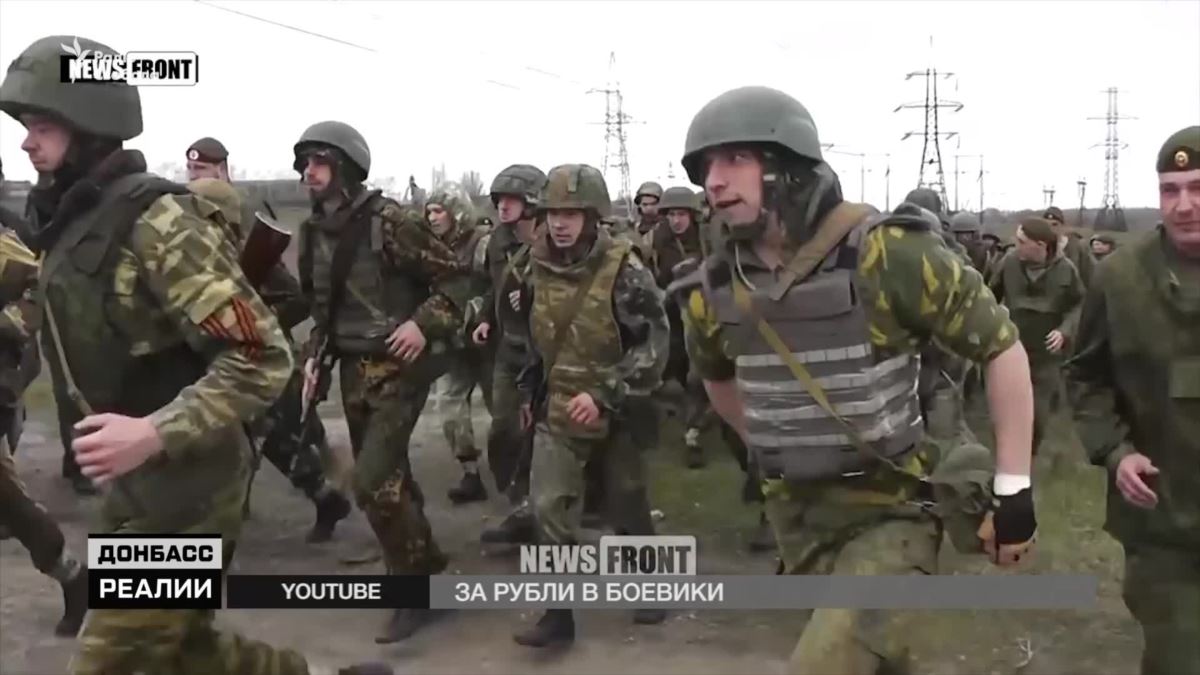Things are heating up in Donbas. In the last 24 hours, there has been a sharp rise in the attacks of the Russian proxy Donetsk and Luhansk "People's Republics" on Ukrainian positions. This has been accompanied by a surge of propaganda alleging Ukraine is planning an attack on Donbas, amid an ever-unraveling narrative of Ukraine's supposed "Donbas genocide." The leaders of the Russian-managed statelets have announced a mobilization of military-age men while ordering an evacuation of women and children.
Driving this assault are info-ops based on fabricated incidents and misrepresented imagery and videos. Disseminated by Russian state media and media of the Russian proxy "republics," they aim to support a pretext for a further military incursion into Ukraine. Here are four incidents of the last week that were disproved by OSINT experts.
CASE ONE: Russian-backed separatists were caught having pre-filmed calls for an emergency evacuation
On 18 February the leaders of the self-proclaimed "Donetsk People's Republic" ("DNR") and "Luhansk People's Republic" ("LNR") published videos on Telegram announcing an evacuation of civilians in response to Ukrainian military activity. "DNR" leader Denis Pushilin specifically states that the date is 18 February, and the videos claimed to have been filmed in response to events occurring that day.
However, OSINT analysts examined the metadata from the videos -- it is retained in the Telegram messenger -- which showed that both were in fact recorded two days earlier, on 16 February, before the supposed announced "Ukrainian attack."
To analyze the metadata, visit this website and upload the video downloaded from Telegram there.
Pushilin's video recorded on Feb 16th too https://t.co/m4QlKJzCd0 pic.twitter.com/vf4SzhRF91
— Mark Krutov (@kromark) February 18, 2022
Serhii Sternenko, who noticed the discrepancy in the metadata of the video with "LNR" leader Leonid Pasichnik, observed that the folder from which the video was uploaded was called "the mongoose lunge" (mongooses make several fake attack attempts after going for their victim for real). A similar operation existed in history: the CIA carried out Operation Mongoose involving terrorist attacks against civilians and covert operations aimed at removing the Communists from power in Cuba.
This strongly indicates that the escalation of hostilities referred to in the films was pre-planned by Russia and its proxies.
CASE TWO: Footage of a car bombing in Donetsk conveniently recorded by blogger linked by researchers to the Russian GRU
On 18 February, images of a car bomb exploding at a parking lot near the “DNR government’s building” were reported by Russian state-linked media, which claimed that the targeted empty vehicle belonged to the head of the so-called "DNR People’s Militia" Denis Sinenkov.
“DNR head” Pushilin labeled it an “act of sabotage” and “preparation for Kyiv’s offensive.”
US government experts have determined that the source of the Donetsk car bomb video which circulated widely on social media was WarGonzo, a popular Telegram channel of Donetsk-based war correspondent and blogger Semen Pegov, whose reporting frequently reflects Russian misinformation on the topics of Russian military and mercenary involvement in Syria, Ukraine, and other regions of the world.
DNR gov't video showing the jeep right after the explosion https://t.co/7Ly0evZLls pic.twitter.com/C1L6ObbHPt
— Aric Toler (@AricToler) February 18, 2022
Pegov scooting himself to the car, calling it a "terrorist attack", lol pic.twitter.com/MDGxkFHyZL
— Aric Toler (@AricToler) February 18, 2022
European disinformation researchers and investigative journalists have linked him to the Russian GRU and the Wagner private military company. The correspondent featured in the car bomb video is Pegov.
Mediazona journalist Anton Pustovalov observed that during the summer, Sinenkov was driving a much more expensive car than the ubiquitous UAZ with the same license plates that exploded. This may mean that the Russian proxy forces chose a cheaper car to be sacrificed in order to showcase a "terrorist attack."
кстати интересней что с этими номерами летом ездило вот это. А 11 дней назад уже был вот этот уазик pic.twitter.com/YnRwiQQfSL
— Antanas Pustovalovas (@djxtrees) February 18, 2022
CASE 3: Kremlin-aligned media circulates dubious and inconsistent footage of a so-called Ukrainian sabotage operation.
On 18 February a video was posted to social media channels including Telegram and Twitter purporting to show forces aligned with the so-called "DNR" engaging a "sabotage group" of the Ukrainian army, close to the city of Horlivka. The occupation authorities of “DNR” reported about two ostensibly foiled Ukrainian plots to cause chemical leaks in the Russian-occupied city of Horlivka, claiming to have killed two Ukrainian “saboteurs” and intercepted “conversations of saboteurs in Polish.”
As usual, all major Russian media relayed this propaganda story without any questioning. The plot echoes January warnings by Ukrainian intelligence that the Russian occupation administration was preparing a false flag attack on a chemical plant in Horlivka to blame Ukraine for using chemical weapons as a pretext to intensify Russian aggression against Ukraine.
“Donbas genocide myth” gets new spin with staged evacuation and foiled false flag “chem attacks”
The video first appeared on the Telegram
on the "People’s Militia of the Donetsk Republic" Telegram channel. It then circulated on Russian language Telegram before being picked up by state-linked media outlet RIA Novosti. Already then, a contradiction was observed by Liveuamap: the RIA agency described it as a video from the camera of one of the saboteurs, but the reporter described it as a video of the militia.
As well, OSINT experts have found that the video has a creation date as early as 8 February, with the metadata revealing that the video was stored in a folder created on 4 February 2022.
https://twitter.com/bellingcat/status/1494994802705850368
Moreover, the metadata shows that initially, the video was titled "2021-02-04ДРГ" ("ДРГ" = диверсионно-разведовательная группа in Russian, translates as "sabotage group" and was stored in a folder titled "Projects\2021\02 February."
Furthermore, an audio analysis indicated that the sound of the explosions was actually taken from another video.
Here's a spectral analysis of the pairs of explosions in the 2 vids, channels from top: DNR vid L/R, M72A5 vid L/R. Sync is perfect. I've highlighted some distinctive features which are identical, many others are visible. There's no question the explosion audio is identical. pic.twitter.com/jvkFfkS75S
— Ciaran Walsh (@mistercw) February 19, 2022
This strongly suggests that the video was staged.
CASE 4: Russian media switches claims following OSINT investigations into kindergarten shelling
On 17th February, reports circulated in international press and social media of shelling having hit a nursery in the Luhansk region of eastern Ukraine. Russian state-linked media reported that the "LNR" had proof that “the shelling came from the direction of Ukrainian forces.”
However, the Kyiv-based propaganda watchdog StopFake debunked this obvious fake report, juxtaposing photographs of the kindergarten's interior and exterior published before the artillery attack with those published by JFO, and referring to a report by the humanitarian mission Proliska
, a Facebook video of Ukrainian soldiers examining the damaged building, and debunking by fact-checkers Bellingcat and InformNapalm. InformNapalm also found that the shell that hit the kindergarten was presumably fired from the "LNR"-controlled territory.
Characteristic of its use of multiple and often contradictory explanations, Russian state media including RT then claimed that the Ukrainian army had conducted the attack in its own territory as a "false flag" operation.
1) Russia shells Ukrainian kindergarten
2) says kindergarten was "LNR's"& starts shouting about "genocide"
3) since thanks to journos it's clear kindergarten was Ukraine's, says Ukraine staged shelling of their own kindergarten
4) still says Ukraine "executes" civilians at UNSC https://t.co/KNGLsv9Lu7— Alya Shandra (@AlyaShandra) February 17, 2022
The “Donbas genocide myth” in the making: a kindergarten shelling case study
Related:
- “Donbas genocide myth” gets new spin with staged evacuation and foiled false flag “chem attacks”
- Сhemical leak in Russian-occupied Donbas may be red-flag operation, Ukrainian intelligence warns
- The “Donbas genocide myth” in the making: a kindergarten shelling case study
- Ukrainian kindergarten and school hit as Russian-hybrid forces escalate hostilities all over Donbas





